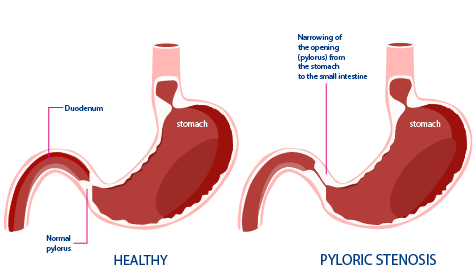Pyloric Stenosis treatment Hospital in Kukatpally
Pyloric stenosis is the thickening of the pylorus muscle existing as a junction between the stomach and the small intestine. It happens to newborns and affects male babies. Projectile vomiting is a prominent symptom of the disease. If not identified and treated in time, it can lead to a life-threatening situation. It can cause severe dehydration in babies, which is a dangerous situation in babies.
Pyloric stenosis is a sphincter muscle that closes and opens for food to pass into the small intestine. When this muscle thickens, the passage to the small intestine narrows and makes the food throw up. Babies do not have this condition in the womb. They develop it only after birth. Pyloric stenosis can also affect older boys. Conditions like peptic ulcers or eosinophilic gastroenteritis can cause the blocking of the digestive passage. The exact cause for this thickening is still unknown. Doctors consider it is the combination of factors like using antibiotics for babies and mothers during pregnancy or during breastfeeding that might be responsible for pyloric stenosis.

Symptoms
1. Vomiting: It begins as sporadic spit-ups and gradually progresses into projectile vomiting. The baby forcefully ejects the food in an arc form. It takes place either immediately after the feeding or hours later. The baby feels hungry after every vomit and doesn’t show any signs of pain initially.
2. Smaller Stools: Babies have fewer and smaller stools because very little food reaches the intestines. Babies can constipate and sometimes have poop with mucus.
3. Severe weight loss: Because very little food goes into the intestine, babies do not receive the nutrition for their growth, which makes them lose weight drastically despite being overfed.
4. Severe dehydration: Babies with pyloric stenosis can dye with dehydration as they vomit whatever they eat or drink. Sunken eyes, sunken “soft spot” on their head, wrinkled skin are the signs of dehydration in babies.
5. Waves of peristalsis: As the belly tries to empty itself against the thickened pylorus, the stomach contractions make ripples that are noticeable to the naked eye.
Symptoms of pyloric stenosis start when the baby is around three weeks old. But it can take up to five months for the symptoms to become apparent. The symptoms are similar to other conditions like gastroesophageal reflux, milk protein allergy, or gastroenteritis.
As home remedies work for these conditions, parents ignore it as a disease that can be cured at home.
• The diagnosis of pyloric stenosis includes a physical examination by the doctor. During the examination, he asks the parents questions about feeding patterns, vomiting patterns, and how the vomit looks like. Provide this information to the doctor promptly so that the doctor can assess the condition quickly.
• The doctors usually check for a lump in the abdomen which feels like an olive. The presence of such a lump is a sure sign of pyloric stenosis. Further, the doctor can ask for an ultrasound scan to inspect the muscle.
• Sometimes, the Barium swallow test is used to detect the condition. In this test, the baby is fed with a small amount of chalky liquid. As the liquid passes through the digestive system, the doctors observe its passage using special x-rays and detect the blockage accurately.
• Blood tests are suggested to check for electrolyte imbalance because of the constant loss of fluids from the body.

Pyloric Stenosis treatment in kukatpally
Symptoms of pyloric stenosis start when the baby is around three weeks old. But it can take up to five months for the symptoms to become apparent. The symptoms are similar to other conditions like gastroesophageal reflux, milk protein allergy, or gastroenteritis.
As home remedies work for these conditions, parents ignore it as a disease that can be cured at home.

